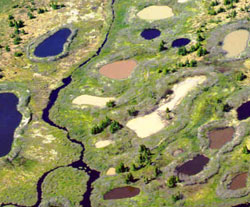Accelerated Climate Change?
Permafrost melting in northern Canada may be adding to the greenhouse gas problem responsible for climate change.
 Dr. Isabelle Laurion, a researcher from the Institut national de recherche scientifique (part of l’Université du Québec) will spend the month of July in Nunavik. She’ll be looking at the way thermokarst ponds, which are formed when the permafrost melts, affect the carbon cycle in the environment. Dr. Isabelle Laurion, a researcher from the Institut national de recherche scientifique (part of l’Université du Québec) will spend the month of July in Nunavik. She’ll be looking at the way thermokarst ponds, which are formed when the permafrost melts, affect the carbon cycle in the environment.
Melted water from the permafrost trickles into peatlands. These are made up of plants that absorbed carbon dioxide to grow and then died and decomposed, causing the carbon to seep into the ground and the air as methane. Water from the permafrost then collects this carbon from the peatlands along the way to forming new ponds. The carbon continues its path through the hydrological network to end up in lakes and oceans where some of it may transform into gas and escape into the atmosphere as carbon dioxide or methane. Since these are greenhouse gases, this cycle could exacerbate climate change.
 Dr. Laurion also studies the composition of these thermokarst ponds in order to discover what other elements could have an effect on the recirculation of the carbon found in northern peat bogs. She will try to establish the difference between typical ponds and the ones formed by the melting permafrost. Dr. Laurion also studies the composition of these thermokarst ponds in order to discover what other elements could have an effect on the recirculation of the carbon found in northern peat bogs. She will try to establish the difference between typical ponds and the ones formed by the melting permafrost.
Contact:
Isabelle Laurion
Tel.:
(418) 654-2694
E-mail:
isabelle_laurion@inrs-ete.uquebec.ca
|
